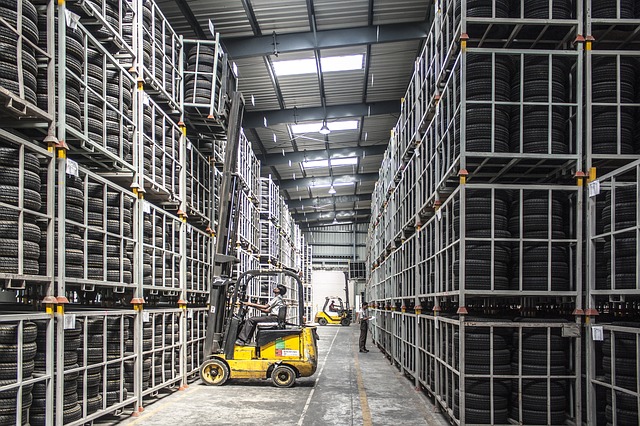Forklift truck
Contents |
[edit] Introduction
Forklift trucks are used to transport materials and goods on pallets or packs, and are able to move them both horizontally and vertically. They are most suited to use on firm and level ground, and so are common in warehouses and on industrial sites, but they are generally designed to operate in poorer conditions as well and so can be used on construction sites.
On construction sites, they are predominantly used as part of the materials and goods storage process, or for moving materials and goods where the height of the structure does not exceed three storeys.
[edit] Types of forklift truck
The common features of forklift trucks include their engine, the driver’s cab, and the lifting forks.
The selection of the appropriate type of forklift truck will depend on considerations such as:
- The load and lifting height required.
- The use of attachments (such as fork extensions, booms, rotating heads, drum clamps, paper roll clamps, bale clamps, load stabilisers and so on).
- Available power sources (electric batteries, liquefied petroleum gas (LPG), petrol or diesel).
- The terrain.
- The need to protect the operator.
- Exposure to the weather.
- The need for lighting.
- Noise restrictions.
There are three basic types of forklift truck:
[edit] Straight mast forklift
This has a telescopic straight mast that extends vertically, typically with a maximum lift height of 5.7 m, a maximum forward tilt of 3-degrees and a maximum backward tilt of 10-degrees. This type of forklift is capable of lifting 1.5 tonnes.
[edit] Telescopic boom forklift
This has a telescopic boom that is able to reach forwards 3.35 m and has a maximum lift height of 8.5 m. The maximum load is 2 tonnes.
[edit] Overhead forklift
This has a hydraulically controlled overhead lifting arm that is able to reach forwards 2.35 m and has a maximum lift height of 6.5 m. The maximum load is 1.5 tonnes.
[edit] Health and safety
According to the Health and Safety Executive (HSE), forklift trucks are involved in about a quarter of all workplace transport accidents.
HSE has published ‘Rider-operated lift trucks: Operator training and safe use, Approved Code of Practice and guidance’ (known simply as ‘L117’) intended for employers and those responsible for the safe operation of lift trucks, as well as those in control of worksites, the self-employed, managers and supervisors.
It includes:
- The main legal requirements relating to lift trucks.
- The Approved Code of Practice.
- Guidance on operator training for stacking rider-operated lift trucks.
- Guidance from HSG6 Safety in working with lift trucks, which it replaces.
The Management of Health and Safety at Work Regulations require that a suitable and sufficient risk assessment is undertaken to protect employees and others, and this is an important part of planning lifting operations. Other obligations include; providing training, proper maintenance and inspection, provision of suitable operating areas and suitable loads, and so on.
Particular care must be taken by operatives to ensure that loads are placed correctly on forks prior to lifting, that the forklift truck is not overloaded, and to reduce the crossing of operating areas with other transport and pedestrian routes.
Other relevant legislation includes:
- Health and Safety at Work etc Act.
- Provision and Use of Work Equipment Regulations (PUWER).
- Lifting Operations and Lifting Equipment Regulations (LOLER).
- Workplace (Health, Safety and Welfare) Regulations.
- Control of Substances Hazardous to Health Regulations (COSHH).
- Construction (Design and Management) Regulations (CDM).
Read about other types of construction plant here.
[edit] Related articles on Designing Buildings
- Back actor.
- Bituminous mixing and laying plant.
- Cherry pickers.
- Compressed air plant.
- Concreting plant.
- Construction plant.
- Construction tools.
- Crane supports.
- Earth-moving plant.
- Equipment in buildings.
- Excavating plant.
- Hoist.
- Lift table.
- Lifting device.
- Lock out tag out LOTO.
- Pallet jack.
- Post lift.
- Road sweeper.
- Scaffolding.
- Scissor lift.
- Stacker.
- Types of crane.
[edit] External references
- Fork Lift Truck Association
- ‘Building Construction Handbook’ (6th ed.), CHUDLEY, R., GREENO, R., Butterworth-Heinemann (2007)
- Major Causes Of Forklift Accidents
Featured articles and news
A change to adoptive architecture
Effects of global weather warming on architectural detailing, material choice and human interaction.
How big is the problem and what can we do to mitigate the effects?
Overheating guidance and tools for building designers
A number of cool guides to help with the heat.
The UK's Modern Industrial Strategy: A 10 year plan
Previous consultation criticism, current key elements and general support with some persisting reservations.
Building Safety Regulator reforms
New roles, new staff and a new fast track service pave the way for a single construction regulator.
Architectural Technologist CPDs and Communications
CIAT CPD… and how you can do it!
Cooling centres and cool spaces
Managing extreme heat in cities by directing the public to places for heat stress relief and water sources.
Winter gardens: A brief history and warm variations
Extending the season with glass in different forms and terms.
Restoring Great Yarmouth's Winter Gardens
Transforming one of the least sustainable constructions imaginable.
Construction Skills Mission Board launch sector drive
Newly formed government and industry collaboration set strategy for recruiting an additional 100,000 construction workers a year.
New Architects Code comes into effect in September 2025
ARB Architects Code of Conduct and Practice available with ongoing consultation regarding guidance.
Welsh Skills Body (Medr) launches ambitious plan
The new skills body brings together funding and regulation of tertiary education and research for the devolved nation.
Paul Gandy FCIOB announced as next CIOB President
Former Tilbury Douglas CEO takes helm.
UK Infrastructure: A 10 Year Strategy. In brief with reactions
With the National Infrastructure and Service Transformation Authority (NISTA).
Ebenezer Howard: inventor of the garden city. Book review.
Airtightness Topic Guide BSRIA TG 27/2025
Explaining the basics of airtightness, what it is, why it's important, when it's required and how it's carried out.























Comments